
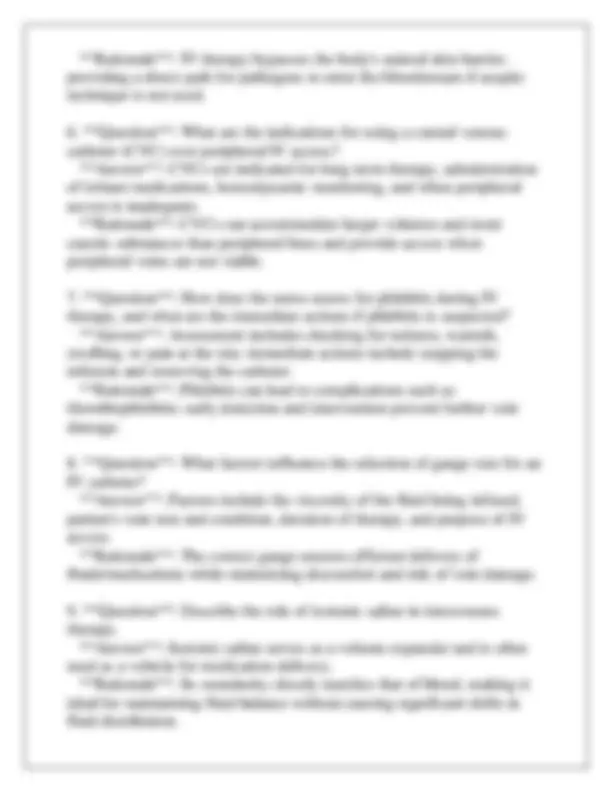
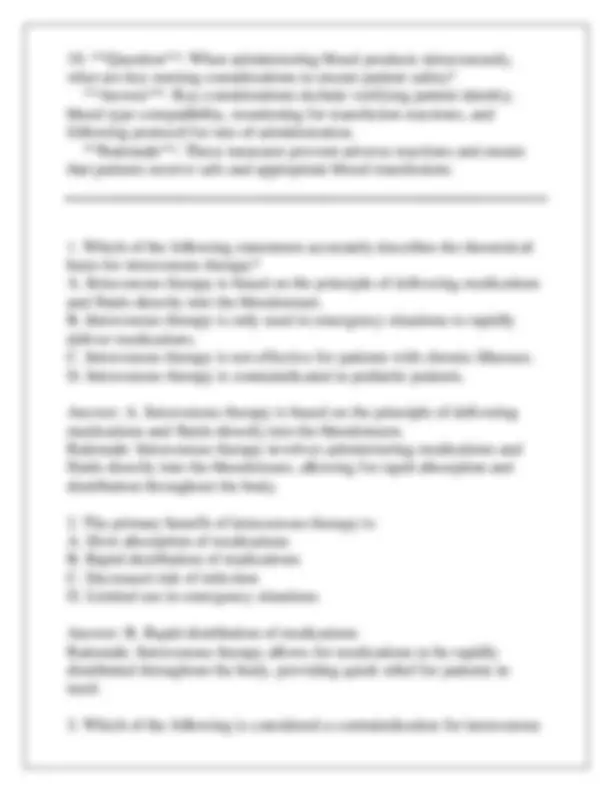
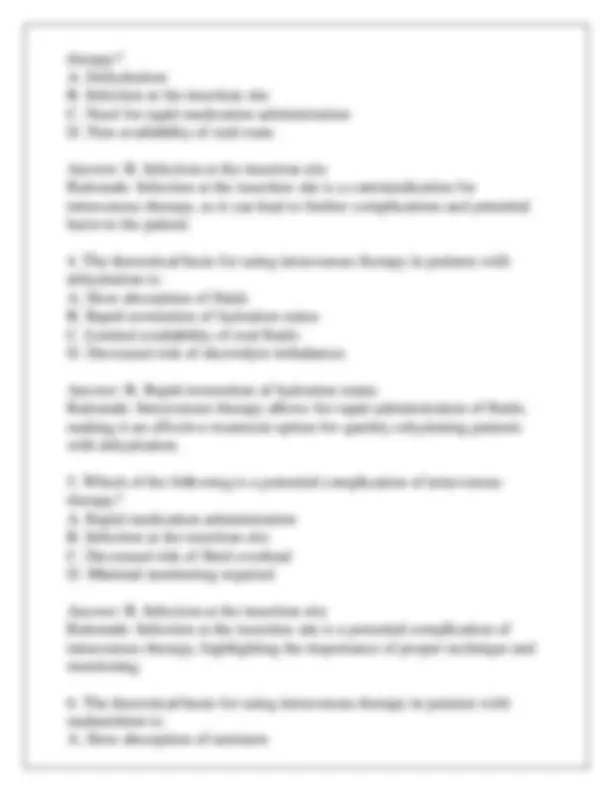
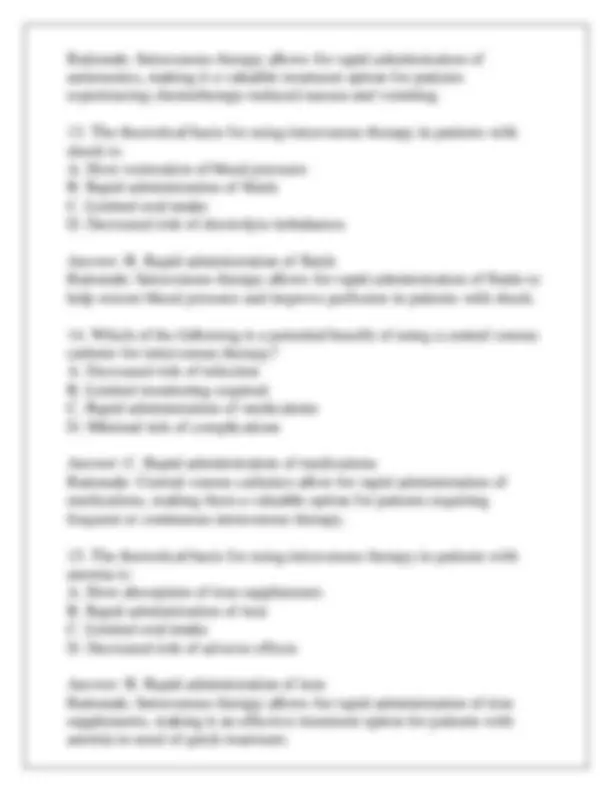
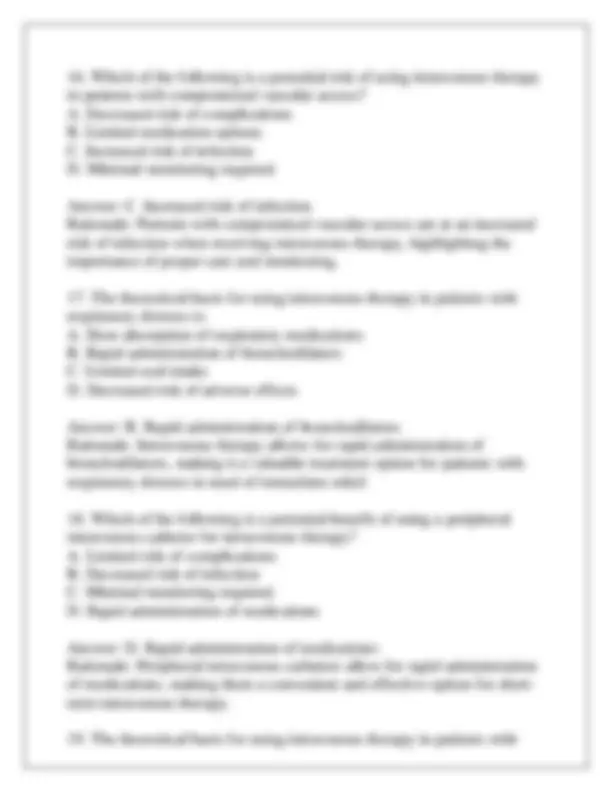

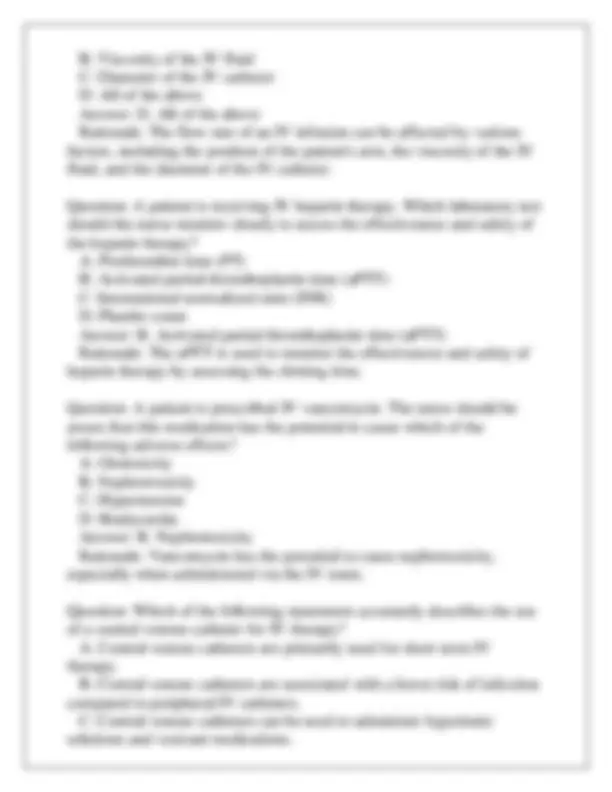
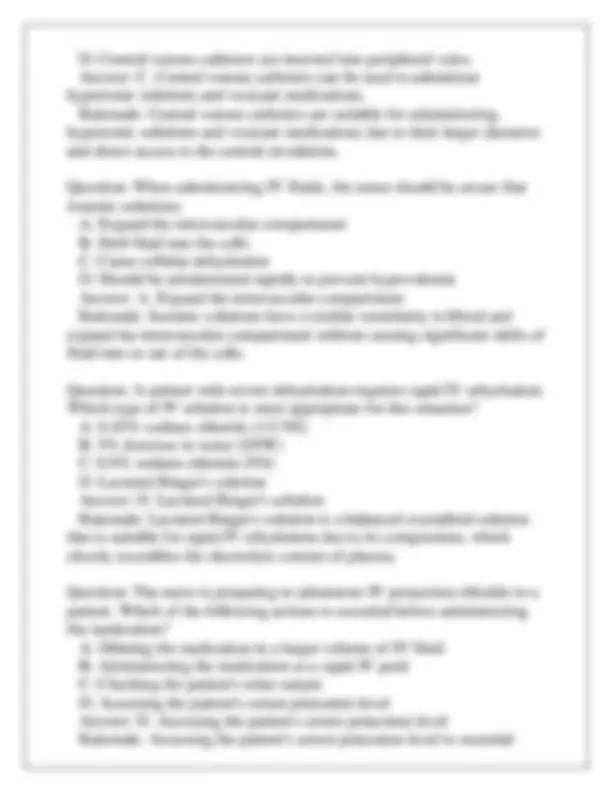
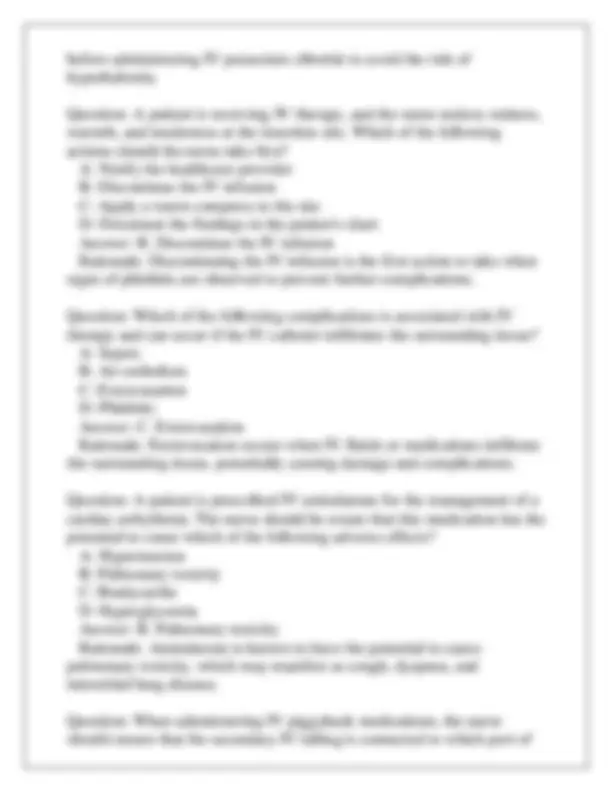
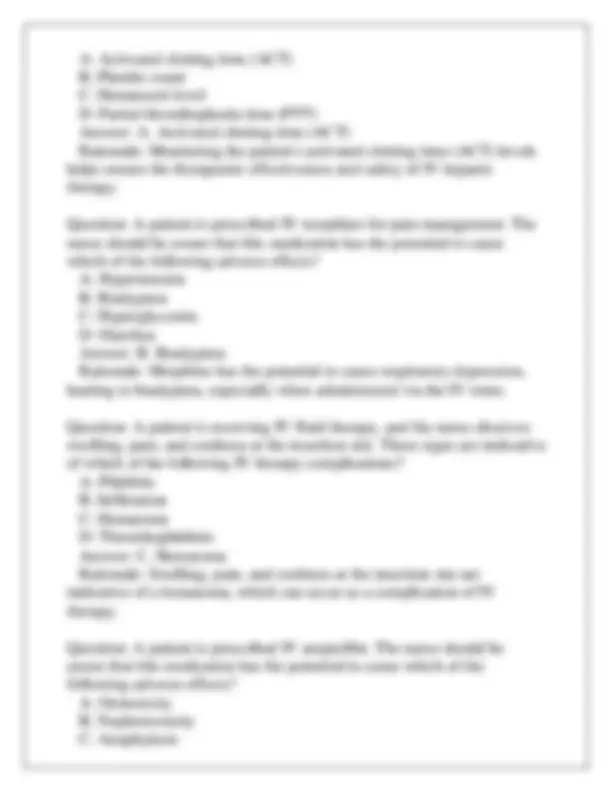
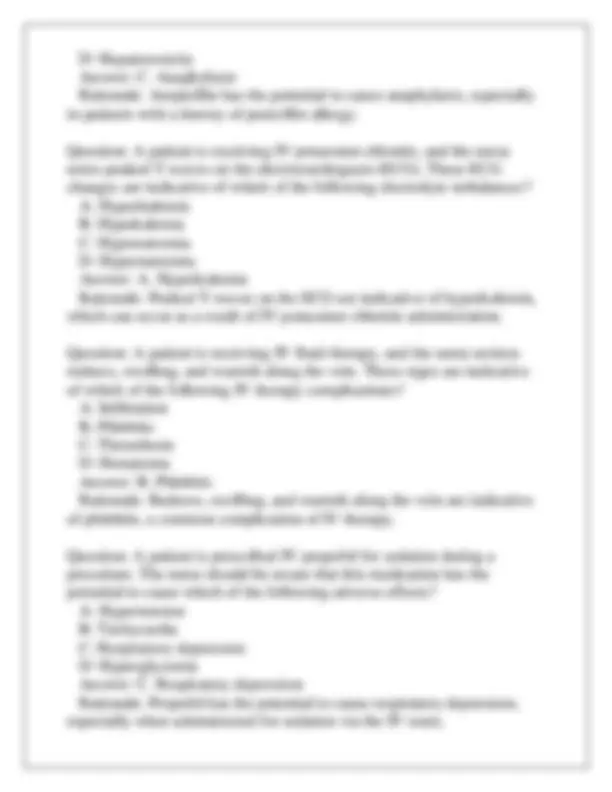



Study with the several resources on Docsity

Earn points by helping other students or get them with a premium plan


Prepare for your exams
Study with the several resources on Docsity

Earn points to download
Earn points by helping other students or get them with a premium plan
Community
Ask the community for help and clear up your study doubts
Discover the best universities in your country according to Docsity users
Free resources
Download our free guides on studying techniques, anxiety management strategies, and thesis advice from Docsity tutors
The principles, benefits, and risks of intravenous therapy, a medical intervention that delivers medications and fluids directly into the bloodstream. It covers various scenarios where intravenous therapy is used, such as dehydration, infection, malnutrition, sepsis, fluid overload, pain, chemotherapy-induced nausea and vomiting, shock, and compromised vascular access. The document also discusses the importance of proper monitoring and documentation.
Typology: Exams
1 / 20

This page cannot be seen from the preview
Don't miss anything!













therapy? A. Dehydration B. Infection at the insertion site C. Need for rapid medication administration D. Non-availability of oral route Answer: B. Infection at the insertion site Rationale: Infection at the insertion site is a contraindication for intravenous therapy, as it can lead to further complications and potential harm to the patient.
D. Decreased risk of electrolyte imbalances Answer: B. Rapid removal of excess fluids Rationale: Intravenous therapy can be used to rapidly remove excess fluids from the body, making it a valuable treatment option for patients with fluid overload.
Rationale: Intravenous therapy allows for rapid administration of antiemetics, making it a valuable treatment option for patients experiencing chemotherapy-induced nausea and vomiting.
hyperkalemia is: A. Slow removal of potassium B. Rapid elimination of excess potassium C. Limited oral intake D. Decreased risk of adverse effects Answer: B. Rapid elimination of excess potassium Rationale: Intravenous therapy allows for rapid elimination of excess potassium, making it an effective treatment option for patients with hyperkalemia in need of urgent intervention.
A. Slow removal of waste products B. Rapid clearance of waste products C. Limited oral intake D. Decreased risk of electrolyte imbalances Answer: B. Rapid clearance of waste products Rationale: Intravenous therapy allows for rapid clearance of waste products in patients with acute renal failure, helping to improve kidney function and overall patient outcomes.
B: Viscosity of the IV fluid C: Diameter of the IV catheter D: All of the above Answer: D. All of the above Rationale: The flow rate of an IV infusion can be affected by various factors, including the position of the patient's arm, the viscosity of the IV fluid, and the diameter of the IV catheter. Question: A patient is receiving IV heparin therapy. Which laboratory test should the nurse monitor closely to assess the effectiveness and safety of the heparin therapy? A: Prothrombin time (PT) B: Activated partial thromboplastin time (aPTT) C: International normalized ratio (INR) D: Platelet count Answer: B. Activated partial thromboplastin time (aPTT) Rationale: The aPTT is used to monitor the effectiveness and safety of heparin therapy by assessing the clotting time. Question: A patient is prescribed IV vancomycin. The nurse should be aware that this medication has the potential to cause which of the following adverse effects? A: Ototoxicity B: Nephrotoxicity C: Hypertension D: Bradycardia Answer: B. Nephrotoxicity Rationale: Vancomycin has the potential to cause nephrotoxicity, especially when administered via the IV route. Question: Which of the following statements accurately describes the use of a central venous catheter for IV therapy? A: Central venous catheters are primarily used for short-term IV therapy. B: Central venous catheters are associated with a lower risk of infection compared to peripheral IV catheters. C: Central venous catheters can be used to administer hypertonic solutions and vesicant medications.
D: Central venous catheters are inserted into peripheral veins. Answer: C. Central venous catheters can be used to administer hypertonic solutions and vesicant medications. Rationale: Central venous catheters are suitable for administering hypertonic solutions and vesicant medications due to their larger diameter and direct access to the central circulation. Question: When administering IV fluids, the nurse should be aware that isotonic solutions: A: Expand the intravascular compartment B: Shift fluid into the cells C: Cause cellular dehydration D: Should be administered rapidly to prevent hypovolemia Answer: A. Expand the intravascular compartment Rationale: Isotonic solutions have a similar osmolarity to blood and expand the intravascular compartment without causing significant shifts of fluid into or out of the cells. Question: A patient with severe dehydration requires rapid IV rehydration. Which type of IV solution is most appropriate for this situation? A: 0.45% sodium chloride (1/2 NS) B: 5% dextrose in water (D5W) C: 0.9% sodium chloride (NS) D: Lactated Ringer's solution Answer: D. Lactated Ringer's solution Rationale: Lactated Ringer's solution is a balanced crystalloid solution that is suitable for rapid IV rehydration due to its composition, which closely resembles the electrolyte content of plasma. Question: The nurse is preparing to administer IV potassium chloride to a patient. Which of the following actions is essential before administering the medication? A: Diluting the medication in a larger volume of IV fluid B: Administering the medication as a rapid IV push C: Checking the patient's urine output D: Assessing the patient's serum potassium level Answer: D. Assessing the patient's serum potassium level Rationale: Assessing the patient's serum potassium level is essential
the primary IV line? A: Distal port B: Proximal port C: Y-site D: Injection port Answer: C. Y-site Rationale: Connecting the secondary IV tubing to the Y-site of the primary IV line allows for the administration of piggyback medications without interrupting the primary infusion. Question: A patient is prescribed IV furosemide. The nurse should monitor the patient for which of the following potential adverse effects of this medication? A: Hypokalemia B: Hyperkalemia C: Hypocalcemia D: Hyponatremia Answer: A. Hypokalemia Rationale: Furosemide is a loop diuretic that can lead to the loss of potassium, potentially causing hypokalemia. Question: A patient is receiving IV chemotherapy. Which of the following actions is essential for the nurse to take to ensure safe administration of the chemotherapy medication? A: Wear double gloves during medication administration B: Flush the IV line before and after the administration of the chemotherapy C: Administer the chemotherapy as a rapid IV push D: Store the chemotherapy medication in the patient's room Answer: B. Flush the IV line before and after the administration of the chemotherapy Rationale: Flushing the IV line before and after the administration of chemotherapy helps prevent contamination and ensures safe administration. Question: A patient is prescribed IV magnesium sulfate. The nurse should closely monitor the patient for which of the following potential adverse effects of this medication?
A: Hypotension B: Hypocalcemia C: Respiratory depression D: Hypothermia Answer: C. Respiratory depression Rationale: Magnesium sulfate has the potential to cause respiratory depression, especially when administered in high doses and at a rapid rate. Question: A patient is receiving IV fluid therapy, and the nurse notices crackles in the patient's lungs, increased heart rate, and shortness of breath. These signs are indicative of which of the following IV therapy complications? A: Fluid overload B: Air embolism C: Septicemia D: Infiltration Answer: A. Fluid overload Rationale: Crackles in the lungs, increased heart rate, and shortness of breath are indicative of fluid overload, a potential complication of IV fluid therapy. Question: Which of the following actions should the nurse take to prevent air embolism during IV therapy? A: Prime the IV tubing with medication before connecting it to the IV catheter B: Ensure that the IV bag is positioned below the level of the patient's heart C: Clamp the IV tubing when changing the IV bag D: Use a filter needle to withdraw medication from an ampule Answer: B. Ensure that the IV bag is positioned below the level of the patient's heart Rationale: Keeping the IV bag below the level of the patient's heart helps prevent the entry of air into the circulation and reduces the risk of air embolism. Question: A patient is receiving IV heparin therapy. The nurse should monitor the patient's aPTT levels and adjust the heparin infusion rate based on which of the following parameters?
D: Hepatotoxicity Answer: C. Anaphylaxis Rationale: Ampicillin has the potential to cause anaphylaxis, especially in patients with a history of penicillin allergy. Question: A patient is receiving IV potassium chloride, and the nurse notes peaked T-waves on the electrocardiogram (ECG). These ECG changes are indicative of which of the following electrolyte imbalances? A: Hyperkalemia B: Hypokalemia C: Hyponatremia D: Hypernatremia Answer: A. Hyperkalemia Rationale: Peaked T-waves on the ECG are indicative of hyperkalemia, which can occur as a result of IV potassium chloride administration. Question: A patient is receiving IV fluid therapy, and the nurse notices redness, swelling, and warmth along the vein. These signs are indicative of which of the following IV therapy complications? A: Infiltration B: Phlebitis C: Thrombosis D: Hematoma Answer: B. Phlebitis Rationale: Redness, swelling, and warmth along the vein are indicative of phlebitis, a common complication of IV therapy. Question: A patient is prescribed IV propofol for sedation during a procedure. The nurse should be aware that this medication has the potential to cause which of the following adverse effects? A: Hypertension B: Tachycardia C: Respiratory depression D: Hyperglycemia Answer: C. Respiratory depression Rationale: Propofol has the potential to cause respiratory depression, especially when administered for sedation via the IV route.